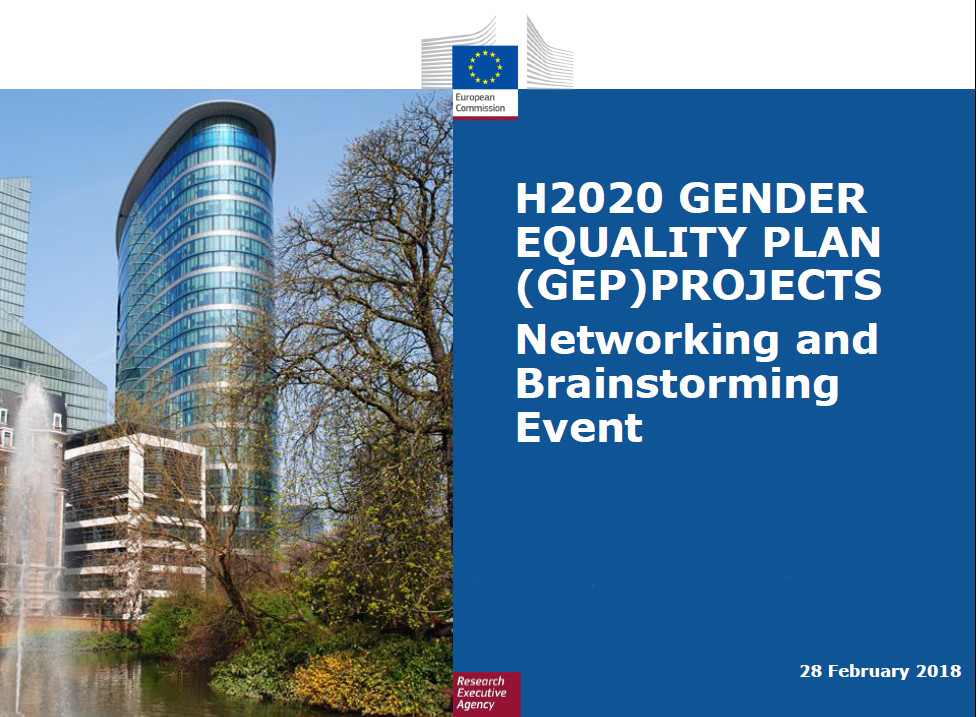Gender Cluster Event: main highlights
On February 28, 2018 an H2020 Gender Equality Plan (GEP) project networking and brainstorming event was organized by Unit B5 of the Research Executive Agency and Unit B7 of DG Research and Innovation.
 Three parallel workshops were organized in a “World Café” style. Each workshop involved approximately 15 participants in funded GEP projects (both from FP7 and H2020), and they focused on GEP implementation, evaluation and sustainability, respectively. Participants at the workshops discussed specific obstacles and barriers encountered within their own organizations, and tried to collectively come up with practical solutions to overcome them.
Three parallel workshops were organized in a “World Café” style. Each workshop involved approximately 15 participants in funded GEP projects (both from FP7 and H2020), and they focused on GEP implementation, evaluation and sustainability, respectively. Participants at the workshops discussed specific obstacles and barriers encountered within their own organizations, and tried to collectively come up with practical solutions to overcome them.
All three of them were structured with one moderator coming from one of the H2020 projects who led and encouraged the discussion and facilitated the exchange of opinions. Tullia Gallina Toschi, coordinator of the PLOTINA project, was the moderator of the third workshop, which focused on the sustainability of GEPs.
Regarding the implementation process, attention was drawn to the importance of employing communication tools, as well as holding regular meetings between partners. It was stressed that this active communication should be used to share good practices among partners. The workshop revealed how fruitful it is for funded projects to learn from one another.
Some of the main obstacles analysed in this workshop were the difficulty in convincing researchers and managers of the importance of including the gender dimension in research. One of the solutions may be the inclusion of gender experts and expertise within research groups. Training that highlights the benefits for institutions may also play a role in overcoming resistance in this issue. Educating staff at all levels is needed. Indeed, the responsibility for pushing the institution towards gender equal development should permeate the organisation, rather than rely on individual people.
Two options for institutionalizing gender equality in organisational structures are the establishing of a gender equality board/committee, or if this is not feasible, the creation of a dedicated equal opportunities office/unit. It is important that both are equipped with sufficient human and economic resources. Nevertheless, even more important than this is that it is essential that gender equality themes permeate the governance and structure of the organisation.
Besides the implementation, attention was drawn to the importance of monitoring and conducting periodic evaluation to assess whether the project is on track and to find solutions to emerging problems, since the data collected constitute empirical evidence of possible gender imbalances. Nevertheless, it was stressed how difficult it is to provide quantitative evidence of the impacts of the project, given the complex nature of the GEPs and their environment.
Surveys were seen as appropriate for measuring the evolution of the cultural values of the staff in relation to gender and gender policies and to assess the results of GEP implementation. It is important for the indicators to be simple, not too detailed, and for electronic and shared online tools to be created for people in charge of the internal evaluation.
Mapping and monitoring the implementation progress, through specific indicators, is essential to demonstrate that change is actually happening and how it works. A good tool to track the progress made in the policy provision is the creation and the publication of a mandatory Annual Gender Report. When creating a kind of portal for gender equality, the GEP on the institutional website provides an opportunity for staff members to find updates on the progress of the implementation.
On a policy level, a common notion was that linking gender equality to the application of national and/or European funds as a mandatory requirement will have the most lasting impact on RPOs and their commitment towards it. This would foster the recognition of the importance of gender equality as a factor for excellence and thus contribute towards a European-wide change in science and research institutions.
See the full report here


Comments are closed.